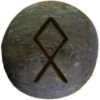Last Updated on March 26, 2025



Symbolism and Meaning
Othila (ᛟ) (also spelled Othala or Odal), pronounced “OH-thee-lah”, represents inherited wealth, cultural values, and ancestral wisdom. It signifies property, traditions, and familial bonds. The rune connects people to their origins. It emphasizes spiritual and material inheritance. Many view it as a rune of legacy. It encourages responsibility toward one’s lineage. It also represents separation. One must leave behind what no longer serves them.
The rune’s shape resembles an enclosed space or a boundary. This signifies ownership and protection. It reflects the idea of sacred land and familial duty. Historically, it linked to noble families and landowners. Some believe it indicates restrictions or obligations tied to inheritance.
Historical Context
Othila appears in early inscriptions across Germanic territories. It was used in legal and territorial matters. Ancient laws often tied inheritance to bloodlines. This rune reinforced those traditions. In Viking Age runestones, it symbolized land rights. It marked areas passed down through generations.
The rune appears in Gothic script as “oþal.” This term meant “heritage” or “estate.” It later influenced Old English and Old High German. The Anglo-Saxon Futhorc included a similar rune. The Rune Poems describe its meaning as wealth passed down by ancestors. These writings reinforce its connection to inherited fortune and duty.
Usage in Eddas and Sagas
Themes of inheritance and ancestral duty are common. Many sagas feature conflicts over land and legacy. In Egil’s Saga, disputes over property drive much of the plot. The same occurs in Njáls Saga and Laxdæla Saga. These works reflect the rune’s core themes of inheritance and duty. ![]()
Practical Applications
Many people use Othila in rune casting. It often appears in readings about family matters. Some see it as a sign of stability. Others interpret it as a warning against clinging to the past. When reversed, it can indicate loss or a break from tradition.
Othila appears in jewelry and carvings. It is sometimes used as a protective symbol for homes. Some engrave it on heirlooms to strengthen connections to ancestry. The rune also appears in legal contexts in historical documents. It signified land ownership and noble status in early Germanic cultures.
Conclusion
Othila carries deep meaning in Germanic tradition. It represents inheritance, family, and protection. Its presence in historical texts and artifacts reinforces its significance. Whether in runestones, legal traditions, or modern practices, Othila continues to symbolize the ties between past and present.
Runes Associated with Othila
Othila (ᛟ) connects with the Gebō (ᚷ) and Fehu (ᚠ) Elder Futhark runes. ![]()
Gebō means “gift” and symbolizes exchange, inheritance, and relationships. Othila represents ancestral land and heritage, while Gebō highlights the bonds that transfer such wealth. Both deal with legacy—one through material inheritance, the other through mutual giving.
Fehu means “cattle” and represents movable wealth, prosperity, and beginnings. Othila, in contrast, represents fixed wealth like land. Fehu’s energy starts wealth accumulation, while Othila secures it for future generations. Together, they show how wealth moves and settles within a family or tribe.
Gebō, Fehu, and Othila form a cycle of wealth: gaining (Fehu), exchanging (Gebō), and preserving (Othila). Each plays a role in maintaining stability and growth.
Its Power in Asatru
Asatruar honor this rune for its connection to lineage and ancestral wisdom. It signifies the land passed through generations, and reminds Asatruar of their duty to protect heritage and kin. Othila also represents spiritual inheritance, linking individuals to their ancestors’ beliefs.
Many use Othila in rituals for home protection and ancestral guidance. It strengthens the connection to one’s roots and traditions. This rune also emphasizes community, reinforcing shared values within a Kindred. It teaches that true wealth is not material but found in heritage and identity. Asatruar view it as a guiding force in preserving their faith and way of life.

